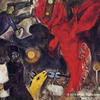6: Painting, Marc Chagall’s "The Falling Angel," 1923–1947.
“Deathfugue” conjures up dramatic images with lines such as “we shovel a grave in the air there you won’t lie too cramped.” Some of this imagery evokes the work created by Marc Chagall (1887-1985), a Russian-Jewish visual artist who lived in France for much of his life. His paintings were often based on emotional, poetic associations and conveyed a kind of dream-like world, reminiscent in some ways of the surreal sensibility of Celan’s poem.
Suggested Activity: Examine Chagall’s The Falling Angel as a class. Ask students to write about the specific images they see and explore possible connotations. Teachers may want to direct their students to focus on some of the following images: the fiery red angel who seems to be falling upward, the blue violin standing in contrast to the flaming red, the crucifixion, the man holding the Torah protectively, turning away from the chaos in the village, and the clock. It would be useful, too, to discuss the somber tone created by the dark color palette, and to examine the few bright spots of color—the candle, the moon, the yellow animal, and the Torah itself.
As a group, discuss these images and invite students to consider how, though seemingly disparate, they work together to form a cohesive whole, one which can be seen as the artist’s response to the suffering of Europe and its Jews during World War II. Then turn back to “Deathfugue.” In what ways is Chagall’s approach to representing European Jewish suffering similar to Celan’s approach? In what ways is it different?
Source: Marc Chagall, “The Falling Angel, 1923-47 by Marc Chagall,” www.MarcChagall.net, 2011, https://www.marcchagall.net/the-falling-angel.jsp.
Marc_Chagall_The_Falling_Angel.jpg
 Download image (415.01 KB)
Download image (415.01 KB)

